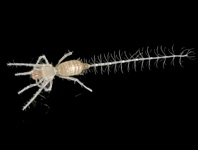Abstract
Current knowledge of the taxonomy and distribution of European cave palpigrades largely rests upon incidental records. Samples seldom comprise more than one or two specimens, and many regions have only been unevenly explored, if at all. The present study is the first to investigate morphological variability within, and differentiation between, subterranean palpigrade populations in a small, geographically coherent area. It is based on relatively abundant material from six localities in the SW Alps (Piedmont, Italy) and two non-Italian comparative localities. Discrete and continuous characters reveal, on the one hand, a close grouping within the Eukoenenia spelaea species-complex, and, on the other hand, a remarkable short-range endemism. The occurrence of five distinct morphologies in a SW Alpine area of just 2000 square kilometres or so indicates that subterranean biodiversity parallels the rich above-ground biodiversity there. The Cottian Alps in the North harbour E. roscia Christian sp. n., E. lanai Christian sp. n. and the widespread E. spelaea. Two caves in the Maritime and Ligurian Alps are populated by E. bonadonai, which was originally described from the Provence Alps, while the Bossea cave in the Ligurian Alps remains the only known locality for E. strinatii. We evaluate the traditionally employed morphological characters and those recently proposed for use in Eukoenenia systematics. Further, we provide data on the formerly undescribed females of E. strinatii and E. bonadonai, and provide comprehensive pictorial information on the SW Alpine cave palpigrades to set new benchmarks for the taxonomy of the E. spelaea species-complex.

